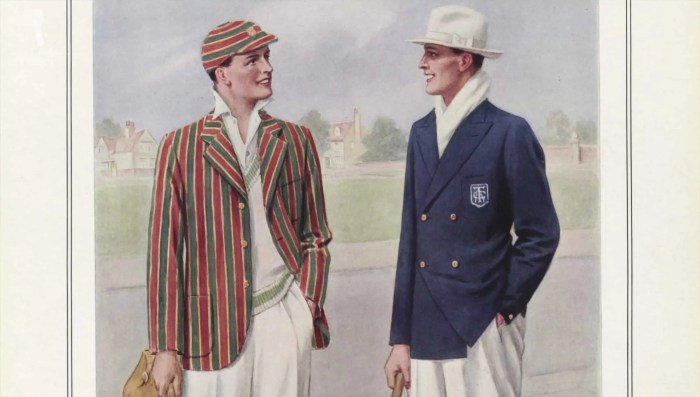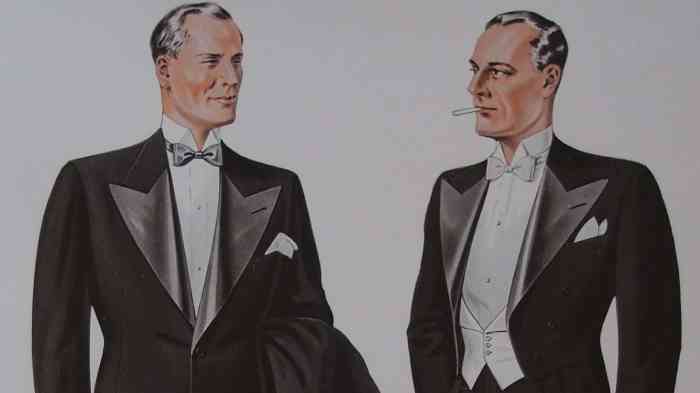1920s Mens Fashion Casual A Style Guide
Defining “Casual” in the 1920s: 1920s Men Fashion Casual
1920s men fashion casual – The concept of “casual” menswear in the 1920s differed significantly from its modern interpretation. Understanding this requires examining the socio-cultural shifts of the era, particularly the aftermath of World War I and the rise of a more relaxed social atmosphere. This period saw a departure from the stringent formality of Victorian dress, paving the way for a more relaxed and comfortable approach to menswear.
The Social Context of 1920s Casual Menswear
The post-war era witnessed a significant societal upheaval. The rigid social structures of the Victorian era began to loosen, leading to a more relaxed attitude towards personal expression, including clothing. Increased leisure time and the burgeoning popularity of automobiles contributed to a demand for more comfortable and practical clothing suitable for a wider range of activities. The flapper era and its embrace of modernity also influenced menswear, though perhaps more subtly than womenswear.
Comparing “Casual” Then and Now
While the term “casual” remains in use, its meaning has evolved drastically. In the 1920s, “casual” still implied a level of neatness and presentability, albeit less formal than attire for business or formal social events. Today, “casual” encompasses a far broader spectrum, ranging from athleisure to styles that would have been considered highly informal, even slovenly, in the 1920s.
The 1920s’ casual attire still adhered to a sense of style and propriety; modern casual wear often prioritizes comfort and practicality above all else.
Evolution of Casual Wear Leading to the 1920s
The transition from Victorian formality to the relative ease of 1920s casual wear was gradual. The late 19th and early 20th centuries saw a slow loosening of the extremely formal styles of the Victorian era. The Edwardian period (1901-1910) retained a degree of formality but hinted at the changes to come. The pre-war years saw the beginnings of a more relaxed approach, but World War I significantly accelerated this trend, as practicality superseded formality for many men.
Timeline of Menswear Formality Shift
A simplified timeline illustrating the shift in menswear formality:
- Victorian Era (1837-1901): Extremely formal attire, with emphasis on tailored suits, stiff collars, and elaborate accessories.
- Edwardian Era (1901-1910): Slight loosening of formality, but still largely formal.
- Pre-World War I (1910-1914): Early signs of a more relaxed approach to menswear.
- World War I (1914-1918): Practicality takes precedence; uniforms and simpler styles dominate.
- Roaring Twenties (1920s): Emergence of a more relaxed and casual style, though still maintaining a sense of neatness.
Key Garments of 1920s Casual Menswear
The essential elements of a 1920s casual outfit were characterized by comfort and practicality, yet still reflected a sense of style. Common fabrics were chosen for their breathability and durability, reflecting both the social climate and the available technologies of the time.
Essential Garments and Fabrics, 1920s men fashion casual
Key garments included the Norfolk jacket, knickerbockers (often paired with long socks and spats), and loose-fitting trousers. Common fabrics included tweed, flannel, corduroy, and cotton. Variations existed depending on social class and geographic location.
Variations in Casual Styles
Wealthier men might favor finer fabrics like cashmere or silk blends, while working-class men opted for more durable and affordable materials. Regional variations also existed, with certain styles being more prevalent in specific geographic areas. For instance, tweed was particularly popular in Scotland and the British Isles, reflecting the region’s heritage and climate.
Garment Details

Source: gentlemansgazette.com
| Garment | Fabric | Typical Style | Social Context |
|---|---|---|---|
| Norfolk Jacket | Tweed, flannel | Loose-fitting, belted | Suitable for outdoor activities, popular across social classes |
| Knickerbockers | Corduroy, tweed | Knee-length trousers, often with gaiters or spats | Popular for sporting activities and casual wear, particularly in rural areas |
| Loose Trousers | Cotton, linen | High-waisted, often pleated | Comfortable for everyday wear, favored by various social groups |
| Overshirt | Flannel, chambray | Button-down, often worn over a shirt | Practical layering piece for various weather conditions |
Accessories and Footwear
Accessories played a vital role in completing the 1920s casual look, adding personality and reflecting individual style. Hats, in particular, were an essential part of a man’s wardrobe, while footwear choices reflected both practicality and fashion trends.
Accessories and Their Significance
- Hats: Essential for both practical and stylistic reasons. Popular styles included newsboy caps, fedoras, and soft-brimmed hats.
- Ties: Often worn loosely or with a more relaxed knot than in formal settings. Silk or knitted ties were common.
- Scarves: Added a touch of warmth and style, often in knitted or patterned fabrics.
- Belts: Functional and stylistic, often made of leather.
Footwear
Footwear for casual wear included leather oxfords, loafers, and boots, depending on the occasion and personal preference. Spats were also commonly worn over shoes, particularly with knickerbockers.
Influence of Sportswear on Casual Fashion
The burgeoning popularity of various sports in the 1920s significantly impacted casual menswear. The functionality and comfort of sportswear garments were increasingly adopted into everyday attire, blurring the lines between athletic and casual wear.
Sportswear’s Impact
Golf, tennis, and other outdoor pursuits fueled the demand for comfortable and practical clothing. Elements like loose-fitting trousers, comfortable sweaters, and practical jackets transitioned from the sporting field to everyday use.
Sportswear and Everyday Casual Wear

Source: gentlemansgazette.com
While sportswear often featured specific design elements tailored to particular activities (e.g., reinforced knees on golfing trousers), the overall principles of comfort and practicality influenced the design of everyday casual wear. The lines blurred as styles adapted for wider use.
Garments Adopted from Sportswear
Examples include the aforementioned loose-fitting trousers, comfortable sweaters (often in argyle or cable-knit patterns), and lightweight jackets suitable for outdoor activities. The influence of sportswear extended to footwear as well, with comfortable athletic shoes gaining wider acceptance.
Visual Representation of Sportswear-Influenced Attire
Imagine a man dressed in a comfortable, loosely-fitting pair of flannel trousers, a cable-knit sweater in a muted color, and a lightweight tweed jacket. He wears leather loafers and a soft-brimmed felt hat, perhaps a newsboy cap. His overall appearance is relaxed yet stylish, reflecting the influence of sportswear on casual fashion.
Impact of Cultural Shifts
The post-war era brought about profound societal changes that had a direct impact on men’s fashion. The rise of automobiles, increased leisure time, and evolving social roles all contributed to a shift towards more comfortable and practical clothing.
Post-War Era and Changing Attitudes
The disillusionment following World War I contributed to a more relaxed social atmosphere. The rigid formality of previous decades gave way to a greater emphasis on individual expression and comfort. This shift was reflected in men’s clothing choices, with a move away from overly stiff and restrictive garments.
1920s men’s casual fashion saw a shift towards looser, more comfortable styles compared to previous eras. This relaxed approach reflects a broader societal change, and to understand its place within the larger context, exploring the evolution of men’s fashion through the decades is helpful. The 1920s, with its relaxed knits and comfortable trousers, truly established a foundation for casual menswear that continues to influence styles today.
Automobiles and Leisure Time
The increasing availability of automobiles provided men with greater mobility and leisure time. This facilitated participation in outdoor activities and led to a demand for clothing suitable for a wider range of pursuits, influencing the adoption of sportswear elements into casual wear.
Changing Roles of Men
The changing roles of men in society, with a growing emphasis on leisure and personal pursuits, also impacted their clothing choices. The need for formal attire for work remained, but the demand for comfortable and practical clothing for leisure activities increased significantly.
Influence of Subcultures
Emerging subcultures also influenced casual menswear. The jazz age, for example, fostered a more relaxed and expressive style, while other groups embraced specific styles that reflected their identity and values.
The Evolution of Casual Style Through the Decade
The 1920s witnessed a continuous evolution in casual menswear styles. While the overall trend was towards a more relaxed and comfortable approach, subtle changes in silhouettes, fabrics, and accessories occurred throughout the decade.
Key Differences Across the Years
The early 1920s saw a continuation of some pre-war styles, with a gradual shift towards looser fits and more comfortable fabrics. By the mid-1920s, the influence of sportswear was more pronounced, with elements like loose-fitting trousers and comfortable sweaters becoming increasingly common. The late 1920s saw a further refinement of these styles, with a greater emphasis on individual expression and a wider variety of fabrics and accessories.
Silhouettes and Cuts
The decade saw a shift from the more structured and fitted silhouettes of earlier eras to looser, more relaxed fits. The emphasis was on comfort and ease of movement, particularly for outdoor activities and leisure pursuits. The use of pleats and looser cuts in trousers became more prevalent.
Societal Trends and Casual Style
The overall stylistic evolution of casual men’s fashion throughout the 1920s reflects the broader societal changes of the era. The increased leisure time, the rise of automobiles, and the changing social attitudes all contributed to a more relaxed and comfortable approach to menswear, moving away from the stringent formality of previous decades. The decade ultimately laid the foundation for the more casual styles that would continue to evolve in the decades to come.
FAQ Summary
What were some common fabrics used in 1920s casual menswear?
Common fabrics included cotton, linen, flannel, and corduroy. These were chosen for their comfort and breathability, reflecting the shift towards more relaxed styles.
How did the Great War influence 1920s casual menswear?
The post-war era brought a desire for comfort and practicality, leading to looser-fitting clothes and a move away from the restrictive styles of the Victorian era. The war also led to a shortage of certain materials, influencing fabric choices.
Were there regional variations in 1920s casual menswear?
Yes, regional differences existed. Coastal areas might favor lighter fabrics like linen, while colder climates saw more use of heavier materials like wool and tweed. Styles also varied based on social class and subcultural influences.





















